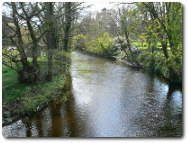Gerard Manley Hopkins, selected poems Contents
Synopsis of Hurrahing in Harvest
Inspiration
 Hurrahing in Harvest is a sonnet written in 1877, whilst Hopkins was studying for the priesthood at St.Beuno's, North Wales. In a note he tells us how it was written: ‘The Hurrahing sonnet was the outcome of half an hour of extreme enthusiasm as I walked home alone one day from fishing in the Elwy', the Elwy being the river that flows through the Vale of Clwyd in which St.Beuno's is situated.
Hurrahing in Harvest is a sonnet written in 1877, whilst Hopkins was studying for the priesthood at St.Beuno's, North Wales. In a note he tells us how it was written: ‘The Hurrahing sonnet was the outcome of half an hour of extreme enthusiasm as I walked home alone one day from fishing in the Elwy', the Elwy being the river that flows through the Vale of Clwyd in which St.Beuno's is situated.
The poem is reminiscent of John Keats' Ode to Autumn. As with Keats, Hopkins gains an almost mystical experience, though, because Hopkins was a Christian, he expresses it much more in religious terms in trying to see God directly in the scene.
More on Keats: Keats, in a letter, describes a similar moment of intense pleasure in looking on the stubble fields whilst on holiday near Winchester. Hopkins' and Keats' poems must be set side by side as two of the best celebratory poems in the English language concerning autumn.
Textual notes
As in a slightly earlier sonnet, The Windhover, Hopkins' language and poetic rhythms are very complex and syncopated. The images, likewise, try to fix the scene exactly: to fix its inscape in the octave and, in the sestet, to work out its particular impression on the onlooker, its instress. The result is a complicated but very rewarding poem.
- Try to recall some autumn scenes you have seen.
- Can you remember the weather and the atmosphere?
Recently Viewed
Related material
Scan and go
Scan on your mobile for direct link.